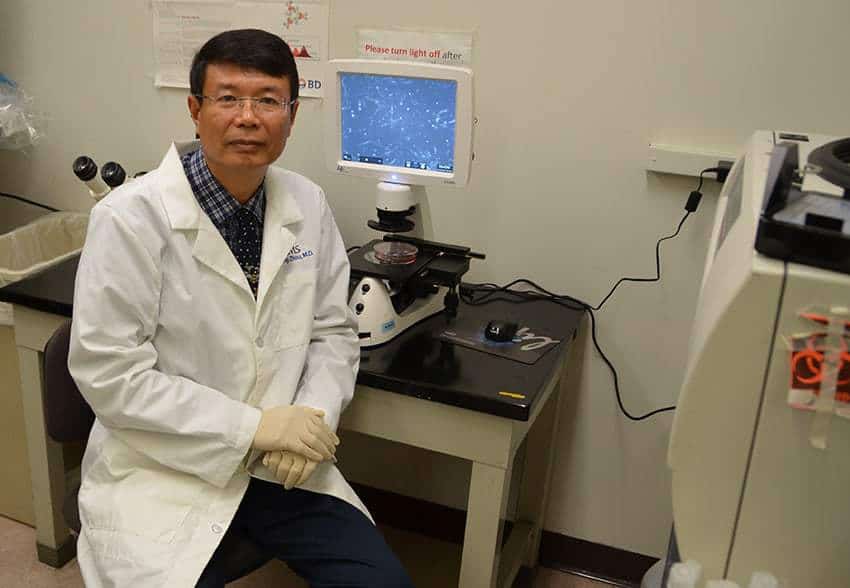$1.8 Million Research Project Grant Marks Third Concurrent NIH Award for UAMS Scientist
| LITTLE ROCK – A scientist at the University of Arkansas for Medical Sciences (UAMS) has reached a status few achieve by being awarded his third concurrent R01-type Research Project Grant by the National Institutes of Health (NIH).
Daohong Zhou, M.D., received the $1.8 million grant to support his research on a therapy to prevent and possibly reverse a lung disease found in patients who undergo radiation therapy for cancer. Zhou is associate director for basic research in the UAMS Winthrop P. Rockefeller Cancer Institute.
“In this era of extreme competition for NIH grants, it’s very uncommon for an investigator to have three R01-type Research Project Grants. This accomplishment speaks to the significance of Dr. Zhou’s research and the confidence his peers have in his ability to accomplish the goals outlined in each of the projects,” said Lawrence Cornett, Ph.D., UAMS vice chancellor for research.
R01-type Research Project Grants are the original and oldest grant mechanism used by NIH. Since 1992, only 27 UAMS faculty members have held three or more concurrent NIH Research Project Grants, including R01 and other grant mechanisms. This award puts Zhou’s current NIH funding at more than $5 million and marks the second time he has held three concurrent R01-type grants, with the first being in 2010.
To illustrate the competitiveness of the grant process, the NIH reports a total of 30,106 applications received for R01-type grants in 2016. Of those, only about 6,000 were funded, for an average award of $458,287.
Zhou’s research aims to revolutionize the management of radiation-induced pulmonary fibrosis (RIPF), one of the most damaging side effects resulting from radiation therapy to the chest. For some people, the signs of RIPF may not appear for months or even years following radiation therapy and can cause shortness of breath, coughing, fatigue and other symptoms. Severe complications can lead to lung failure.
There is no drug therapy available to prevent or reverse RIPF, and treatment options are often limited to easing symptoms.
One of Zhou’s research goals is to develop a safe and effective treatment for RIPF using senolytic drugs, which are designed to selectively kill old or senescent cells. Use of such drugs could alter the course of RIPF by providing the first treatment available for the condition.
“Our research team is examining whether cellular aging, also called senescence, is primarily responsible for initiating the development and progression of radiation-induced pulmonary fibrosis. If our hypothesis holds true, clearance of the old cells could not only prevent or delay disease progression, it also could reverse existing tissue fibrosis even after it has begun,” said Zhou, also a professor of pharmaceutical sciences and deputy director of the Division of Radiation Health in the UAMS College of Pharmacy’s Department of Pharmaceutical Sciences.
UAMS is the state’s only health sciences university, with colleges of Medicine, Nursing, Pharmacy, Health Professions and Public Health; a graduate school; a hospital; a main campus in Little Rock; a Northwest Arkansas regional campus in Fayetteville; a statewide network of regional campuses; and eight institutes: the Winthrop P. Rockefeller Cancer Institute, Jackson T. Stephens Spine & Neurosciences Institute, Harvey & Bernice Jones Eye Institute, Psychiatric Research Institute, Donald W. Reynolds Institute on Aging, Translational Research Institute, Institute for Digital Health & Innovation and the Institute for Community Health Innovation. UAMS includes UAMS Health, a statewide health system that encompasses all of UAMS’ clinical enterprise. UAMS is the only adult Level 1 trauma center in the state. UAMS has 3,275 students, 890 medical residents and fellows, and five dental residents. It is the state’s largest public employer with more than 12,000 employees, including 1,200 physicians who provide care to patients at UAMS, its regional campuses, Arkansas Children’s, the VA Medical Center and Baptist Health. Visit www.uams.edu or uamshealth.com. Find us on Facebook, X (formerly Twitter), YouTube or Instagram.###
